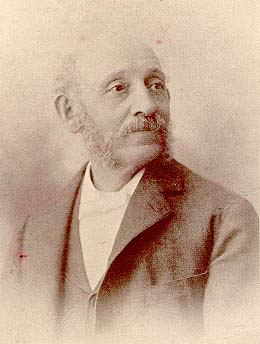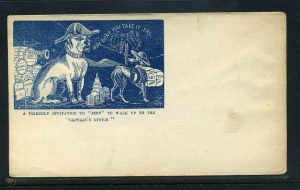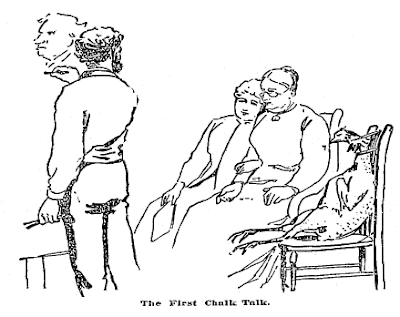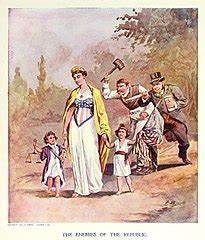America’s First War Cartoonist
Thousands of excited Ohioans rushed to enlist in the U.S. Army when news broke of the attack on Fort Sumter in April 1861. Cincinnati native Frank Beard walked to Camp Dennison where officers judged potential recruits’ fitness for duty. Despite his intelligence, robust physique, and enthusiasm, the young man feared immediate rejection, as a huge obstacle loomed in his way. Beard was stone deaf.
Beard concocted a clever ruse to conceal his disability. He memorized questions posed by examiners in their proper order but was betrayed by a fellow candidate, allowing officers to have some fun at his expense by changing the interrogation sequence. “How old are you?” one officer asked. “Frank Beard,” he replied. “What is your name?” “Nineteen years old,” Beard declared. A half-dozen questions followed before officers erupted in laughter, driving the poor fellow from the building. Sometime later, a sympathetic captain from the Seventh Ohio Infantry approached the young man with a proposition.

If Beard joined his company without pay, the captain promised him a uniform and a gun. Beard agreed and endured three years of service. He was never wounded, despite the Seventh’s involvement in many of the bloodiest battles of the Civil War. His first taste of combat was defeat at the hands of Brigadier General John B. Floyd’s Confederates, who attacked their camp at Kessler’s Cross Lanes, Nicholas County, Virginia on August 26, 1861. Beard and his regiment fought at Antietam, Chancellorsville, Gettysburg, Missionary Ridge, and Resaca, among many others. When the regiment mustered out in 1864, 274 men had died from combat or disease.
Beard enjoyed special treatment from officers in the Seventh. During their campaign in western Virginia, the men had gone nearly an entire day without water. Beard grabbed a canteen from Lt. Colonel Creighton’s Black servant, prompting a dress-down from the colonel. “You fellows riding along on your horses don’t know how we fellows on foot suffer,” Beard lamented. “If I had a horse like you, I wouldn’t grumble and I wouldn’t growl at the fellows who grabbed canteens to save their lives.” The bemused Creighton suggested he find a horse. “I would if I could,” Beard replied, “but if I did you wouldn’t let me ride it.” The colonel insisted that he would, joking that Beard could take one from the cavalry two miles away.
That evening, Beard crept into the cavalry camp and made off the best mount he could find. The cavalry departed before daylight without noticing the missing animal. Beard rode the horse for more than a year without objection from Creighton. In the meantime, Beard began sketching scenes of camp life, battles, and cartoons of his own ideation. He had published cartoons as a young teen in Thomas W. Strong’s popular humor magazine Yankee Notions, so his unofficial position as an army sketch artist seemed a perfect fit.
Beard’s early efforts in his new role won him instant acclaim and lasting fame as creator of the first war cartoon. While General Winfield Scott was defending the capital against potential invasion by the Confederate Army in the late summer and fall of 1861, Beard penned a rough sketch picturing Scott as a bulldog opposite a skulking, emaciated hound representing Confederate President Jefferson Davis. Between the dogs was a fat rib bone labeled “Washington.” Beard sent the sketch to the Department of the Ohio in Cincinnati where, to use twenty-first century parlance, the image went viral.

Brigadier General Ormsby Mitchell’s staff asked Beard to refine the drawing, then distributed it throughout the North. Newspapers and popular magazines published it. Cincinnati merchants lithographed it, selling copies for ten cents each. Envelope manufacturers coopted it for their patriotic covers. He failed to copyright the image, depriving him of a small fortune, but Beard’s sketches were soon in high demand for Harper’s Weekly and other publications, earning him far more than he would have made as an enlisted army private.

Beard moved to New York at war’s end to pursue a career as an illustrator and cartoonist. He struggled for a time, eating cheese and crackers and walking the streets nightly, unable to pay for lodgings. But the war period was a boon to illustrated newspapers and other print media. Beard eventually illustrated numerous postwar recollections and placed his cartoons in newspapers and magazines. His most heralded creation from the 1870s, however, was known as “chalk talk” lecture. What began as a fundraising scheme for his local Methodist church became a nationwide sensation.

Beard composed stories, delivering them orally to an audience while using colored crayons and an easel to illustrate his key characters and narrative. The lectures covered philosophy, humor, and satire. Before long, Beard was overwhelmed with invitations to speak and began charging upwards of $50 per event. Twenty years later, more than a hundred lecturers were touring the country performing chalk talks.[1]

During the late nineteenth century, Beard shifted his focus from secular and political subjects to social reform and moral improvement. He signed on as editor and cartoonist of the popular Methodist weekly The Ram’s Horn in 1890, using pen and wit to combat what he viewed as rampant decadence in Gilded Age America. His bullseye targets were tavern keepers, liquor manufacturers, and corrupt politicians. Beard quickly won the admiration of the Anti-Saloon League, who printed many of his illustrations in their leaflets. Methodist leader Charles Wesley quipped, “There is no reason why the devil should have all the best tunes and it is equally hard to conceive why he should have all of the best pictures.”
Beard would not live to see the decades-long struggle for Prohibition finally succeed, albeit with unintended consequences. His illustrations were so influential in mobilizing public opinion that historian Joanna Scutts dubbed him “The Cartoonist Who Drew America Dry.” He overcame his disability to make a meaningful contribution to Union war propaganda while employing his many talents to promote cherished social causes.[2]
Sources:
[1] Morning Oregonian, 15 Sept. 1895. Beard recollected that he was 18 years old when he joined the Seventh. He was nineteen.
[2] Joanna Scutts, “Frank Beard: The Cartoonist Who Drew America Dry,” Tales of the Cocktail, 6 Nov. 2015, accessed at Axis of Logic Archived, http://axisoflogic.com/artman/publish/Article_72052.shtml.
Thank you for this excellent post
Great article, David
ECW should put together another book–one on Civil War artists! We sure have written about them often enough–probably because they were all such an interesting bunch and because we still laugh with cartoonists today. Thanks for this one.